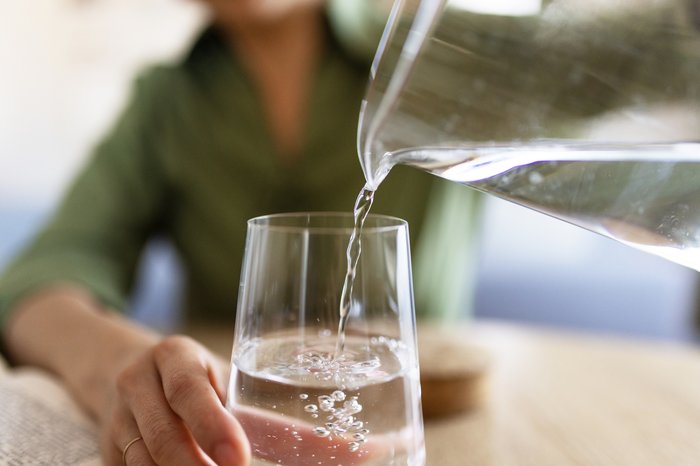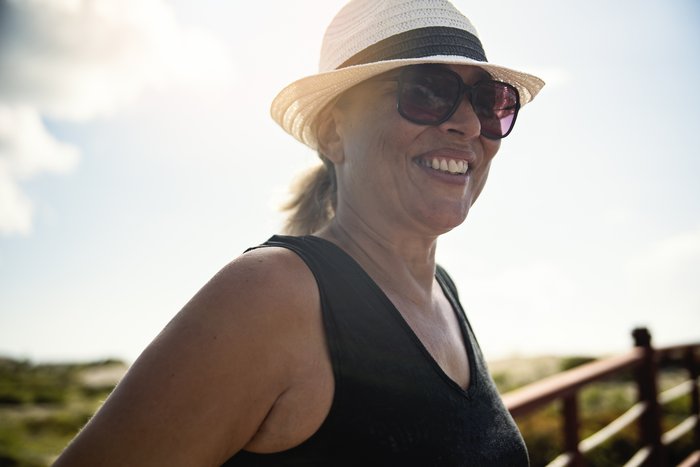In the summer months, you may need to take extra care in high temperatures if you are living with kidney disease, are on dialysis, or are a kidney transplant recipient.
- Research has shown there is a 30 per cent increase in hospital admissions for kidney-related disease during hot spells.
- Another study suggests that exposure to high temperatures may increase the risk of hospitalisations for chronic kidney disease (CKD).
- In addition, transplant recipients are at higher risk of skin cancers.
Professor Alan Salama, consultant nephrologist at the UCL Centre for Nephrology at the Royal Free Hospital, London, says people with CKD, dialysis patients and transplant recipients can help prevent acute kidney injury (AKI) and skin cancers by taking some simple steps to maintain fluid balance in hot weather and by protecting their skin.
What happens to your kidneys in hot weather
“In hot weather you sweat a lot so you lose more fluids and in normal circumstances this will drive your thirst to replenish more fluids,” explains Professor Salama.
“What the kidneys normally do to compensate for fluid loss is try to reabsorb fluids, so that’s why urine becomes more concentrated.
“This combination of thirst driving drinking more, and the kidneys reabsorbing more fluid, helps restore the body’s fluid balance and avoid the body becoming dehydrated. This is partly driven by stimulation of nerves that supply the kidney.”
But if you have CKD, are receiving dialysis treatment, or are a transplant recipient, your kidneys will not be working as normal, and you may need to take extra care to maintain your fluid balance.

Hot weather and CKD
“People who have chronic kidney disease who just have some fluid retention, such as swelling of the ankles, and are on diuretic drugs, just need to make sure they are replenishing their fluids, to keep fluid levels in balance,” says Professor Salama.
“There is no daily set volume of fluid to drink; generally, thirst is a pretty good indicator of if you need to drink more. It’s often said, but not true (apart from maybe in some elite athletes), that by the time you feel thirsty you have caused harm by not drinking enough.
“Water is the best fluid to drink; rehydration salts can be added to water as well which can be beneficial. But the main thing is to avoid drinks that are too sugary, as they don’t reduce thirst in the same way. Tea and coffee are okay, but water is best. Although alcoholic drinks such as beer and lager are mainly water, they have other unhealthy effects so don’t rely on them for hydration.”
Professor Salama says on a really hot day someone with CKD who is taking diuretics (medication that makes you pee more), or blood pressure tablets (which can make kidney function worse if you don’t have enough fluids), may want to miss their tablets for the day, although if you can take on more fluids you don’t necessarily need to do this.
“Although we don’t normally advise people to consume more salt, in very hot weather having a little bit extra will help retain fluids in the body.”
Tips for avoiding dehydration in hot weather
The following measures will help you stay cool and stop you losing too much fluid in sweat.
- stay out of the sun at the hottest times of day, between 12 and 3pm
- avoid sunbathing and stay in the shade and wear a hat
- reduce activity in hot weather (the more active you are, the more fluids you use)
- be aware of the signs of dehydration including peeing more, strong-smelling yellow urine, feeling dizzy and light headed, feeling tired, dry mouth, lips and tongue and sunken eyes
Hot weather effects on advanced CKD and dialysis patients
Fluid levels are very important if you are on kidney dialysis because you have a tendency to accumulate more fluid as your kidneys can’t make as much urine as they should, explains Professor Salama.
“Dialysis patients tend to have to be a bit more careful about how much they drink and some will be on a fluid restriction set by their kidney team. However, they may have to drink a little more in hot weather to compensate, but if they drink too much fluid they may start to retain too much, so it’s a very fine balance,” says Professor Salama.
“Unfortunately, there is no one-size-fits-all advice for dialysis patients on fluid intake in hot weather as it depends on how much urine their kidneys are making and how much fluid they are accumulating between dialysis sessions, so they should consult their kidney team as the advice will be very individualised.
“How much they should drink will depend on individual fluid restrictions assessed by their kidney team.”
Kidney failure or dialysis patients may still feel thirsty but may still need to restrict how much they drink as too much fluid will be retained and cause symptoms of fluid overload such as breathlessness, swelling of the face and/or ankles, high blood pressure, headaches and low energy and, over time, enlargement of the heart.
Checking your weight and blood pressure regularly during a hot spell is a good way to assess if you are losing too much fluid. “If both are going down then you need to tell your kidney team,” says Professor Salama.
Managing high temperatures as a kidney transplant recipient
Donor kidney organs do not have the usual nerve supply that stimulates the kidneys to balance fluid loss. This is because the pre-existing nerve network is not connected to the new kidney.
“This means that if you sweat more in hot weather, less blood will reach the kidney and the kidney’s filter function will be reduced, so more toxins build up, and ultimately this can result in acute kidney injury,” explains Professor Salama.
“Whilst that is generally reversible once you start drinking again, if that goes on for too long it can cause a slightly more established problem in the kidney. These individual ‘knocks’ will build up cumulatively and cause permanent damage such as scarring and damage to the cells in the kidney.”
To avoid dehydration, stay out of the sun at the hottest times of the day, sit in the shade, wear a hat and keep replenishing fluids (even if you don’t feel thirsty).

Risks of skin cancer for kidney transplant recipients
If you’ve had a kidney transplant you also need to take care in the sun because of a greatly increased risk of developing skin cancers.
This is because the immunosuppressant (anti-rejection) drugs you are taking affect the body’s immune surveillance, which is very important for DNA repair and preventing cancer.
Dr Justine Hextall, a consultant dermatologist at University Hospitals, Sussex, and the private Tarrant Street Clinic in Arundel, Sussex, explains
- transplant patients are at 100 times greater risk of developing squamous cell skin cancer, the second most common type of skin cancer
- six times more likely to develop a basal cell carcinoma, the most common type of skin cancer
- four times more likely to develop a melanoma, the most serious type of skin cancer which is most likely to spread.
“Transplant patients are particularly at risk if they have had previous skin cancers or sun damage and sun damage skin conditions such as actinic keratosis, or if they are fair-skinned,” says Dr Hextall. “People who are immunosuppressed are also more at risk of skin cancers spreading, so it’s really important that they are dealt with quickly before they get a chance to do this.”
Dr Hextall says transplant recipients with sun damage skin conditions such as actinic keratoses (dry, scaly patches of skin that have been damaged by the sun), should have the condition treated with cryotherapy (a freezing treatment), or topical creams such as the chemotherapy drug fluorouracil (5FU) or imiquimod, which kills abnormal cells and reduces the risk of skin cancers developing.
“In fact, it’s best to treat the whole field (surrounding area) as there may be subclinical damage that isn’t visible; so, for example, if there are actinic keratoses patches on the scalp, the whole scalp area should be treated,” says Dr Hextall.
“Good communication between dermatology and kidney teams is crucial.”
Other ways to reduce your skin cancer risk include:
- wearing a high factor 50 suncream all year round
- avoiding sunbathing and sunbeds at all times
- protecting the skin with clothing, and
- wearing a hat (especially important if you have a bald head)
Skin cancer risk in advanced CKD and dialysis patients
“Having advanced kidney disease or being on dialysis are associated with a higher risk of non-melanoma skin cancers, so you also need to avoid sunbathing and sunbeds and wear factor 50 suncream all year round if you are in these groups,” says Dr Hextall.